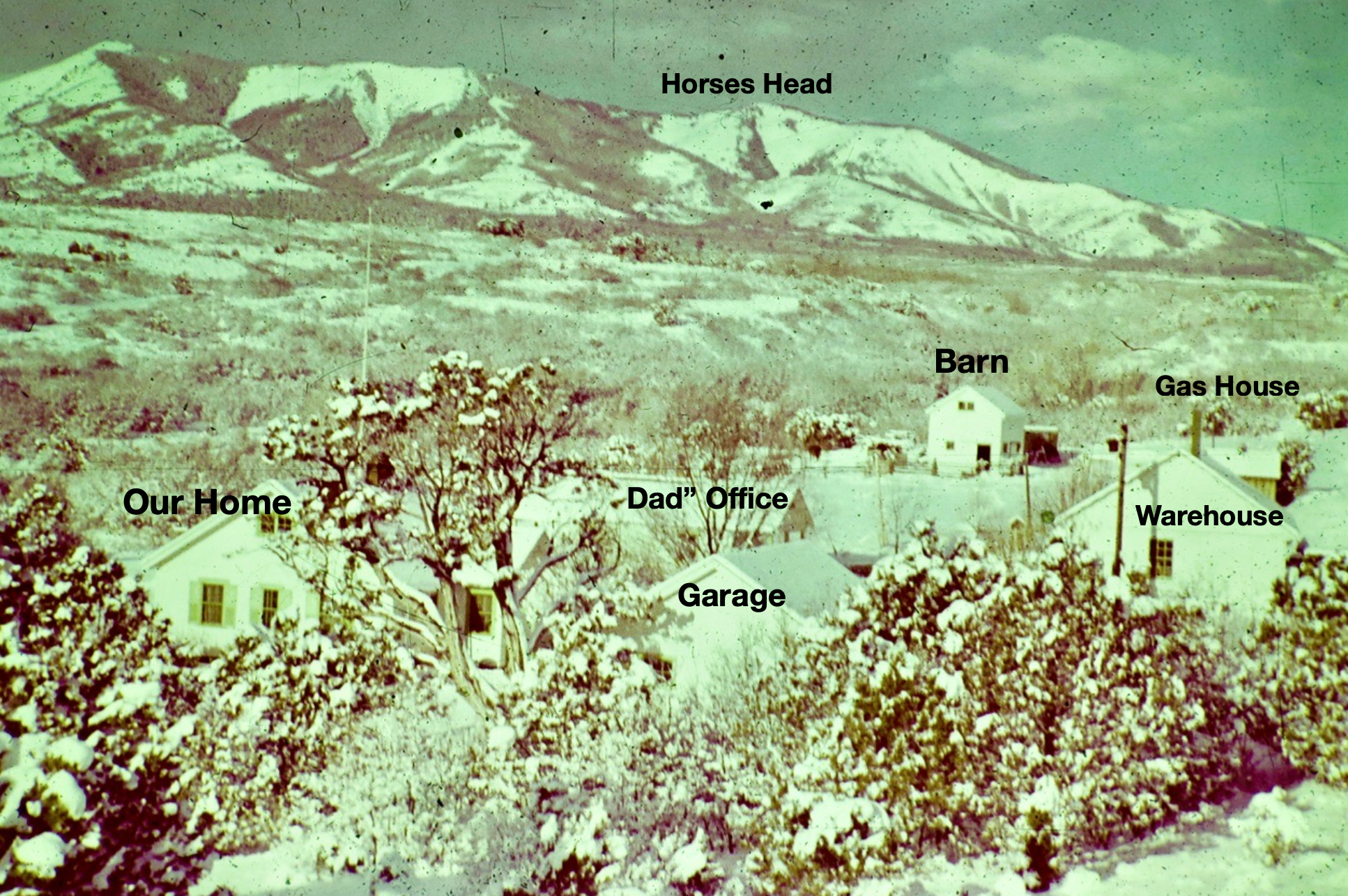When I was growing up in Monticello, there were two stores, two gas stations, and a movie theater. The only school accommodated all of the grades for many years until a new high school was built. I loved the small, white one-room church house where we met before the new chapel was built. During one Sunday meeting when I was a little girl, the sacrament was being passed at the same time and I was squirming in anguish because I needed to go to the bathroom. My mother wanted me to wait until after the sacrament before I left the chapel. I felt that I could not wait any longer, so the only alternative was to relieve myself on the metal chair where I was sitting. The people in the church congregation could hear the water dripping on the clean hardwood floor, which Mother didn’t appreciate. From then on, I never had a problem getting permission to go to the bathroom.
Above is a photograph of the Ranger Station. It consisted of our home on the far left, the garage just to the right, my dad’s office across the street from our home, and the warehouse to the right of my dad’s office. In the middle of the photo, there is a gas house for the truck. It’s hard to see beyond the warehouse and the barn, which is the last building to the right. We were based at the bottom of the Aboho mountain, which you can see in the background. We lived about one mile from the small town of Monticello. Also, to the left is a bunkhouse with only two rooms; it isn’t visible in this photo. Within the bunkhouse, one room was the kitchen and living room. The bedroom was behind this room. The bunkhouse was for people to use who came to visit the forest. There was also an outhouse at the bunkhouse and another one was located down a hill to the left of our home. In our home, we had a flush toilet and also an outhouse. When our cousins came from Provo and Salt Lake, we teased them about flushing it.
At that time, the Baker Ranger houses were all painted white, with green roofs. There were two bedrooms, a kitchen, a living room, and a bathroom on the main floor. In the hall, we had a pull downstairs. Neal, Jay, and Jared all had rooms upstairs. Our yard was big and we made good use of it by playing croquet, hide and seek, and red rover, red rover. Just beyond the yard were the two tree houses that Jared and I built. This is a sketch of the ranger station complex. This is a drawing of the family home. My bedroom was the window on the right. The window to the left was the living room. The back far window was my parent’s bedroom. My dad’s office was across the street from the family home. Dad worked long hours, often into the evening. After dinner, when my father was working, Jared and I would join him, by playing in the back room on some of the old, discarded adding machines. It was fun for us to play like we were grownups working in an office. As I was growing up, I had no idea how incredible our childhood was. (I didn’t realize how lucky we were until I went to New York and saw the open fire hydrants and the kids playing in the street.) Being raised in such an open, creative environment made a huge impression on my life. If we could dream up an idea and receive permission from our parents, we carried it out. This included everything from building two treehouses, making a canvas swimming pool, catching wild chipmunks, and much more.
An artist with whom I worked in food styling painted the picture on the left. It was originally a photo of me. The photo on the right depicts my brother, Jared, who was two years younger than me. He is with our dog, Boot, who was our special friend that we played with. The building in the back is the Warehouse. You can also see the rock wall which was about six feet high It extended all along the north side of the driveway. The photo to the left is a picture of Neal, me, and Jay. The photo to the right is a picture of me holding Jared.
The five of us had our version of paradise at the Monticello ranger station. It included 240 acres of land. Huge cedars and junipers with hollyhocks at their feet surrounded our green frame home. We raised our chickens, beef, horses, mules, and produce. And we were surrounded by some of the most beautiful lands this nation has to offer. My brother Jared —who was just two years younger than I —was my playmate, and life for us took place on the edge of the wilderness. We used to say that “Adventure” was our middle name.
The drawings that accompany this article may appear to be a child’s renditions, but I drew them, as an adult. While I am usually a right-handed person, I created these drawings with my left hand.

Gas House
This was our gas house. We loved this building. It was equipped with an old gas pump with a glass cylinder on the top. To see how much gas you were pumping into the car, you would pump the gas up into the cylinder. There were notations on the glass. These were markers for one gallon, two gallons, etc. As I remember, you could pump up to 10 gallons. Once you had the gas pumped to the amount you wanted, you placed the gas nozzle inside the truck and the gas then filled the tank. Even as a kid, I always knew that when we got gas on the road, I knew how to pump the gas to complete the sale. This was long before there was self-service at the gas pump.
Basketball:
A basketball hoop was located right next to the gas house. We spent hours playing basketball. Basketball was a fun challenge for me. By the time we left Monticello when I was twelve, I was good at making a layup shots and shooting baskets. In Salt Lake City, I played on our church ball teams and scored 36 points during one of our games.
Tree Houses
One of the most memorable activities we had was building a treehouse. Dad helped us put a ladder in the tree and placed a couple of two-by-fours above the ladder to support the upper deck. That’s right—we had a two-level treehouse. There was plenty of old lumber for building supplies, and we were able to use every tool you could imagine. We would go to the warehouse and design and cut the pieces of lumber we would need to put the floor on the ladder and then put a cover over it. Our treehouse was the place to go when we wanted to hide out and have a game or two without being bothered by anyone else.
Sand Pile
We had a big sand pile where we would design and build castles. We also got trucks for Christmas and we could build roads, bridges, and small towns. Right above the sand pile was our pets’ graveyard, where we would bury our small pets when they died. I especially remember our pet turtles. When one of them died, we wrapped it in toilet paper and put it in a metal Band-aid box. Then we had a funeral. After we put the Band-aid can in the ground, we would cover it up and put a cross in the ground to mark the grave. (see below)
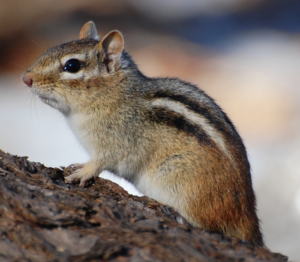

The photo of baby chipmunk was taken one year after they were born. Babies on left are the oldest.
Pet Chipmunks
Chipmunks were common animals that ran wild on the property. We designed and created several traps to catch them. We even built a special chipmunk pen by digging a three-foot hole in the ground and then filling a wooden box with wheat and wool for the chipmunks to make a place to hibernate during the winter. We ran a pipe up to the top of the ground and then built a big wire pen around a bicycle wheel. We wrapped a widescreen around it so the chipmunks would have a path to run.
The chipmunks loved to run on the wheel. Then, when it started spinning too fast, they would jump off. One day, when I was in the pen feeding the chipmunks, one of them ran up my pant leg. I grabbed my leg, placing my hand around it so that the chipmunk could not keep running upward. Then I let out a scream. The chipmunk took off and ran down my pant leg.
This is a closeup of the portion of the compound picture that shows the chipmunk wheel.
Being the only girl in my family meant I spent more time doing what my brothers did rather than participating in girls’ activities. But I did play house, uniquely. One year, Neal and I decided his pet chipmunks needed help to survive the winter. How did we think they ever survived without us? The solution required a lot of improvising. We built a “hibernation” hole lined with soft wool and stocked with plenty of wheat. Then, above ground, we built a pen. After several successful winters, we decided the fuzzy little creatures thoroughly enjoyed their winter home, mainly because they not only stayed alive for us, but they also presented us with baby chipmunks to add to our collection in the spring.
We had a fascination with chipmunks. We spent much of our time devising ways to snare the animals. All it took was a little creative thinking. One of my traps was a steel pipe filled with wheat. The chipmunk would crawl in and we’d clap our hands over both ends. Another trap required a board sprinkled with wheat and topped by a box propped up by a stick. When the chipmunk crawled into the box to “dine”, we’d yank the string we had tied to the stick and the box would fall on it. We would then take the chipmunk out and put him in our master pen, where he had plenty of food, a nice place to hibernate, and a bicycle wheel with a screen around it on which to run.
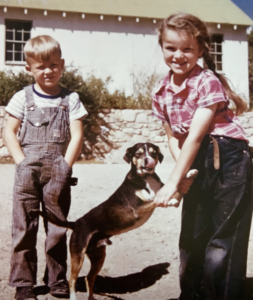
Pet Dog, Boots
Our dearest pet was our dog, Boots. I don’t remember him going to a lot of places with us, but he just seemed to be there whenever we wanted to play with him and enjoy his company.
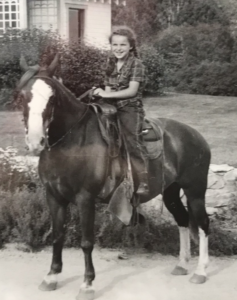
Pet Horses
There were many horses and mules that rangers used in the forest. We had a horse named Ginger that we rode, but we had one that was called Ginger that we rode as kids. I loved to go with my father when he would take an extra horse for me to ride. When we were not out in the mountain riding the horse, we often saddled him and rode around the forest service complex. Once in a while, we got to ride to town on our horses.
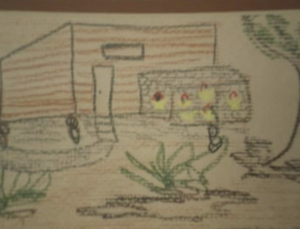
Chickens
The chicken coop was located about 100 yards up the hill. We had a dozen chickens that kept our family in eggs. It was often Jared’s and my job to go to the chicken coop and gather eggs. We would love to throw out the wheat and watch the chickens flock to us and eat. While they were occupied, I checked their nests to gather the eggs. My favorite experience was to get a big egg and then rush back to the kitchen to see if it was a double-yolk egg. We learned that brown hens laid brown eggs and white hens laid white eggs, but there is not any other difference between a white egg and a brown egg, except for the color of the shell.
Our chickens were range chickens and their eggs were real organic eggs because we would often feed the chickens table scraps. That just means they were healthy. We didn’t know about “range chickens” and “organic” eggs back in those days.
Milking the Cow
We had a Jersey cow named Puggy. It took Jared and me a while to get the hang of how to milk a cow, but, with a lot of practice, we finally succeed in landing some milk in the bucket. Often, the one that was milking would turn the cow’s nipple to the side to see if we could squirt milk into the other one’s mouth. This was great fun, and as we practiced, we got better and better at aiming the milk.
After milking the cow, we would put the milk through a strainer and put it in a large glass bowl in the fridge. The next morning, we could go in and skim off the best part, the cream. What Jared and I loved most was when my mother would make cream puffs. She whipped the cream and then added a little sugar before putting it in the puffs. They were the best.
This is the barn where Dian learned to milk Puggy the Cow. Puggy is shown at the barn door.
Shoeing Horses and Fixing Trucks
One of our favorite buildings was the warehouse. Whenever the horses needed to have new shoes, Jared and I would run to help the men. At one end of the warehouse, there was a blacksmith’s fire and bellows. After starting a fire, we turned the crank, which added air to make the fire glow so that the horseshoes would heat up so that they could be bent to fit the horse’s hooves.
It seems like whatever we did, we learned so much from each experience. This whole experience resembled a diorama that you might see in a living history museum now. We saw and learned all about caring for animals firsthand at a very early age. On the other side of the warehouse was a pit for the trucks that needed repair. Drivers would drive over the pit. Then a repairman would jump into the hole and repair the trucks. We were always entertained by the activities that went on in our everyday life living at the Ranger Station.
Wood Pile
Just behind the warehouse was a big woodpile. Wood from the forest was cut into 12-inch logs and then piled for us to use to fill our cooking stove and to heat the water for our house. Jared and I would take turns seeing which one could split a log with one stroke. Then our job as to take the wood into the basement where we would keep a small stove burning that would heat the water. We also used coal from a big coal bin as it would burn longer. We also had a wood stove that my mother cooked on until I was about eight years old when we got an electric stove.
Beavers in the Tank
One day when we went up into the barn, we found two huge water tanks. There was a ladder so that we could walk to the top and peek inside. Inside the tank, there was about a foot and a half of water. There were three live beavers in each tank. We kept ourselves highly entertained during the next week while the beavers were in our backyard. The Forest Service employees were using the tank to hold the beavers before they moved them to the other pond so that they could make beaver dams to hold the water in new ponds.
